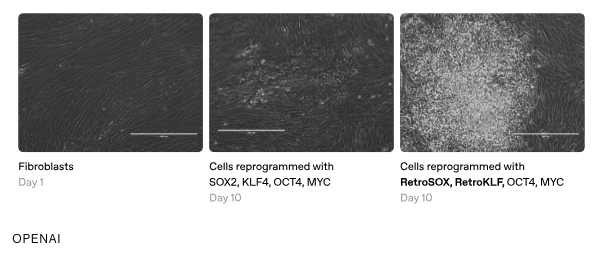Key Points:
- Cellular reprogramming is an emerging technology that uses proteins called Yamanaka factors to revert cells to a younger state.
- Retro Biosciences utilized ChatGPT4b to make the Yamanaka factors 50 times more effective.
OpenAI’s CEO Sam Altman made headlines nearly two years ago after revealing his $180 million investment in Retro Biosciences, a biotechnology company in Northern California focused on human longevity (living longer). Now OpenAI and Retro Biosciences are joining forces to tackle what some have called true age-reversal technology — cellular reprogramming.
What is Cellular Reprogramming?
Cellular reprogramming is a groundbreaking biological technique based on the Nobel Prize-winning discovery of Japanese scientist Shinya Yamanaka. It allows one type of cell to convert into another, effectively resetting the cell’s identity and function. This technology can drastically change the purview of longevity research while generating a paradigm shift in biology.
Cellular reprogramming typically involves changing the expression patterns of specific genes within a cell using four key transcription factors—Oct4, Sox2, Klf4, and c-Myc (collectively known as the Yamanaka factors)—to reprogram mature cells into developmentally younger cells. By reprogramming aged cells to a younger state, scientists can study the processes of aging and develop interventions that might rejuvenate tissues or even whole organisms.
However, while the risk of tumorigenesis seeding from reprogramming seems to have been overcome, there remain challenges in converting a high yield of cells. Overall, cellular reprogramming holds tremendous potential but requires careful refinement and regulation to realize its full therapeutic and scientific value.
ChatGPT4b
According to MIT Technology Review, ChatGPT4b is OpenAI’s first model specifically designed for biological data. Its purpose is to engineer proteins, specifically the Yamanaka factors needed for cellular reprogramming. Retro Biosciences approached OpenAI about a year ago to begin the protein engineering project.
Using ChatGPT4b, Retro Biosciences was able to increase the yield of cells transformed by cellular reprogramming. Before ChatGPT4b, the cellular reprogramming process rejuvenated only 1% of cells treated with the four Yamanaka factor proteins. After training ChatGPT4b to reconfigure the Yamanaka factors, preliminary results showed that the proteins could be 50 times more effective.
“Just across the board, the proteins seem better than what the scientists were able to produce by themselves,” John Hallman, an OpenAI researcher, told MIT Technology Review.

Next Steps for Retro Biosciences
Retro Biosciences aims to discover how to prolong the human lifespan through targeting autophagy — our cellular disposal and recycling system — microglia — our brain’s resident immune cells — and cellular reprogramming. By harnessing the computing power of ChatGPT4b, Retro has already seemingly made at least one great stride in the cellular reprogramming arena.
The next step may be to implement the newly engineered Yamanaka factors in longevity experiments. One worry is that the Retro Yamanka factors, affecting far more cells, could increase the risk of tumor growth in mice. With this in mind, Retro could determine if their Yamanaka factors can prolong the lifespan of mice more effectively than the original Yamanaka factors without tumorigenesis. If so, ChatGPT4b may have placed Retro Biosciences ahead of companies like Rejuvenate Bio, which previously showed that the original Yamanaka factors can prolong the lifespan of mice.
With that being said, large language models other than ChatGPT, such as Pharma.AI are also focused on improving biological research. With more AI-based companies contributing to the progression of biological research, we may see advances come sooner rather than later.